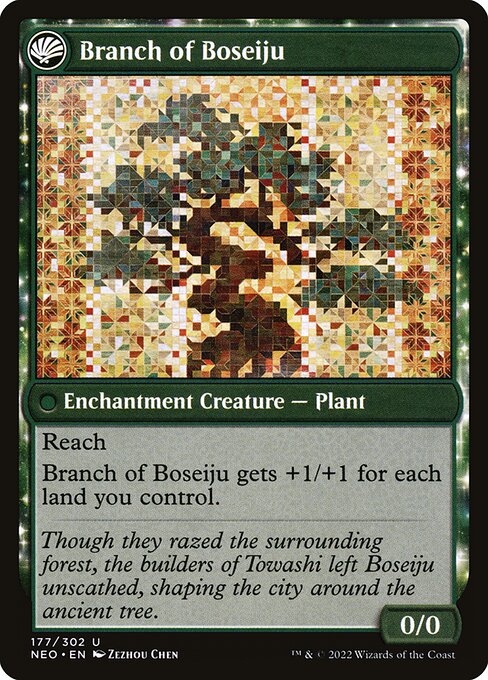天空に到る母聖樹 // 母聖樹の枝
//
エンチャント — 英雄譚 // クリーチャー・エンチャント — 植物
(この英雄譚が出た際とあなたのドロー・ステップの後に、伝承カウンター1個を加える。)
I — あなたのライブラリーから基本森・カード最大2枚を探し、公開し、あなたの手札に加える。その後、ライブラリーを切り直す。
II — あなたの墓地にある土地・カード最大1枚を対象とする。それをあなたのライブラリーの一番上に置く。
III — この英雄譚を追放する。その後、これを変身させた状態であなたのコントロール下で戦場に戻す。 // 到達
母聖樹の枝は、あなたがコントロールしている土地1つにつき+1/+1の修整を受ける。
I — あなたのライブラリーから基本森・カード最大2枚を探し、公開し、あなたの手札に加える。その後、ライブラリーを切り直す。
II — あなたの墓地にある土地・カード最大1枚を対象とする。それをあなたのライブラリーの一番上に置く。
III — この英雄譚を追放する。その後、これを変身させた状態であなたのコントロール下で戦場に戻す。 // 到達
母聖樹の枝は、あなたがコントロールしている土地1つにつき+1/+1の修整を受ける。
0/0
standard
future
historic
gladiator
pioneer
explorer
modern
legacy
pauper
vintage
penny
commander
brawl
alchemy
paupercommander
duel
oldschool
premodern
Rulings
The mana value of a transforming double-faced card is the mana value of its front face, no matter which face is up.
If you are instructed to put a card that isn't a double-faced card onto the battlefield transformed, it will not enter the battlefield at all. In that case, it stays in the zone it was previously in. For example, if a single-faced card is a copy of Azusa's Many Journeys, the chapter III ability will cause it to be exiled and then remain in exile.
Each face of a transforming double-faced card has its own set of characteristics: name, types, subtypes, abilities, and so on. While a transforming double-faced permanent is on the battlefield, consider only the characteristics of the face that's currently up. The other set of characteristics is ignored.
The back face of a transforming double-faced card usually has a color indicator that defines its color.
A transforming double-faced card enters the battlefield with its front face up by default, unless a spell or ability instructs you to put it onto the battlefield transformed or you cast it transformed, in which case it enters with its back face up.
Each transforming double-faced card in this set is cast face up. In every zone other than the battlefield, consider only the characteristics of its front face. If it is on the battlefield, consider only the characteristics of the face that's up; the other face's characteristics are ignored.
If you are instructed to put a card that isn't a double-faced card onto the battlefield transformed, it will not enter the battlefield at all. In that case, it stays in the zone it was previously in. For example, if a single-faced card is a copy of Azusa's Many Journeys, the chapter III ability will cause it to be exiled and then remain in exile.
Each face of a transforming double-faced card has its own set of characteristics: name, types, subtypes, abilities, and so on. While a transforming double-faced permanent is on the battlefield, consider only the characteristics of the face that's currently up. The other set of characteristics is ignored.
The back face of a transforming double-faced card usually has a color indicator that defines its color.
A transforming double-faced card enters the battlefield with its front face up by default, unless a spell or ability instructs you to put it onto the battlefield transformed or you cast it transformed, in which case it enters with its back face up.
Each transforming double-faced card in this set is cast face up. In every zone other than the battlefield, consider only the characteristics of its front face. If it is on the battlefield, consider only the characteristics of the face that's up; the other face's characteristics are ignored.
Rulings
The mana value of a transforming double-faced card is the mana value of its front face, no matter which face is up.
If you are instructed to put a card that isn't a double-faced card onto the battlefield transformed, it will not enter the battlefield at all. In that case, it stays in the zone it was previously in. For example, if a single-faced card is a copy of Azusa's Many Journeys, the chapter III ability will cause it to be exiled and then remain in exile.
Each face of a transforming double-faced card has its own set of characteristics: name, types, subtypes, abilities, and so on. While a transforming double-faced permanent is on the battlefield, consider only the characteristics of the face that's currently up. The other set of characteristics is ignored.
The back face of a transforming double-faced card usually has a color indicator that defines its color.
A transforming double-faced card enters the battlefield with its front face up by default, unless a spell or ability instructs you to put it onto the battlefield transformed or you cast it transformed, in which case it enters with its back face up.
Each transforming double-faced card in this set is cast face up. In every zone other than the battlefield, consider only the characteristics of its front face. If it is on the battlefield, consider only the characteristics of the face that's up; the other face's characteristics are ignored.
If you are instructed to put a card that isn't a double-faced card onto the battlefield transformed, it will not enter the battlefield at all. In that case, it stays in the zone it was previously in. For example, if a single-faced card is a copy of Azusa's Many Journeys, the chapter III ability will cause it to be exiled and then remain in exile.
Each face of a transforming double-faced card has its own set of characteristics: name, types, subtypes, abilities, and so on. While a transforming double-faced permanent is on the battlefield, consider only the characteristics of the face that's currently up. The other set of characteristics is ignored.
The back face of a transforming double-faced card usually has a color indicator that defines its color.
A transforming double-faced card enters the battlefield with its front face up by default, unless a spell or ability instructs you to put it onto the battlefield transformed or you cast it transformed, in which case it enters with its back face up.
Each transforming double-faced card in this set is cast face up. In every zone other than the battlefield, consider only the characteristics of its front face. If it is on the battlefield, consider only the characteristics of the face that's up; the other face's characteristics are ignored.
Your collection? Your decks?
Want to manage your collection and/or create decks?

